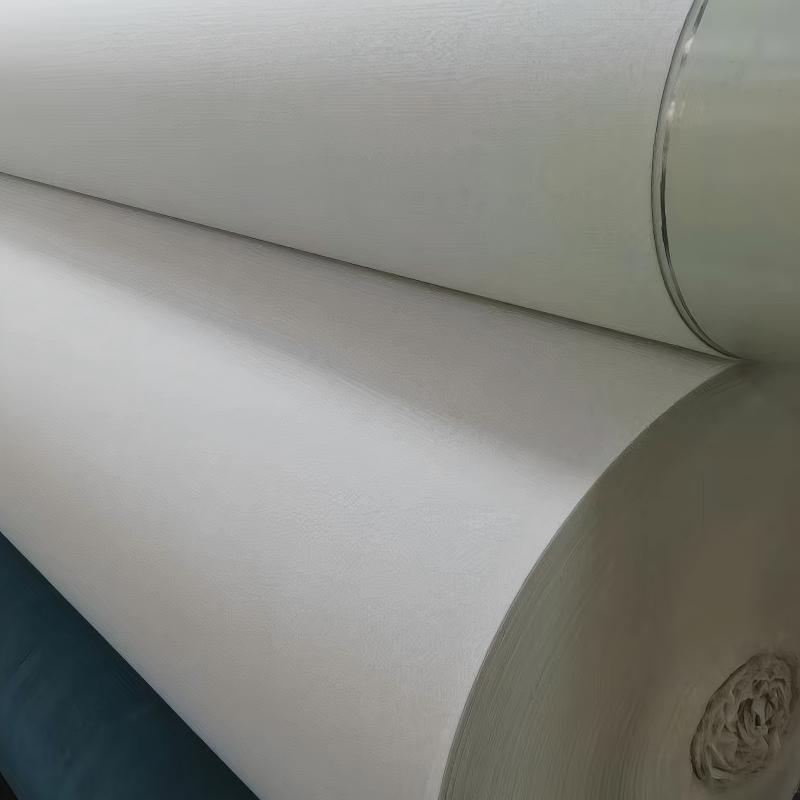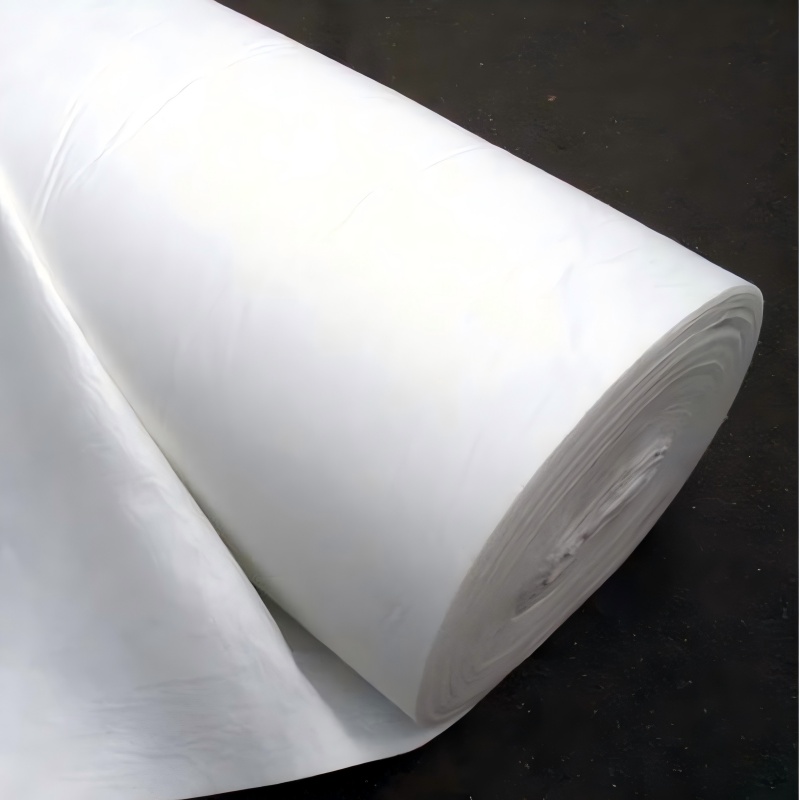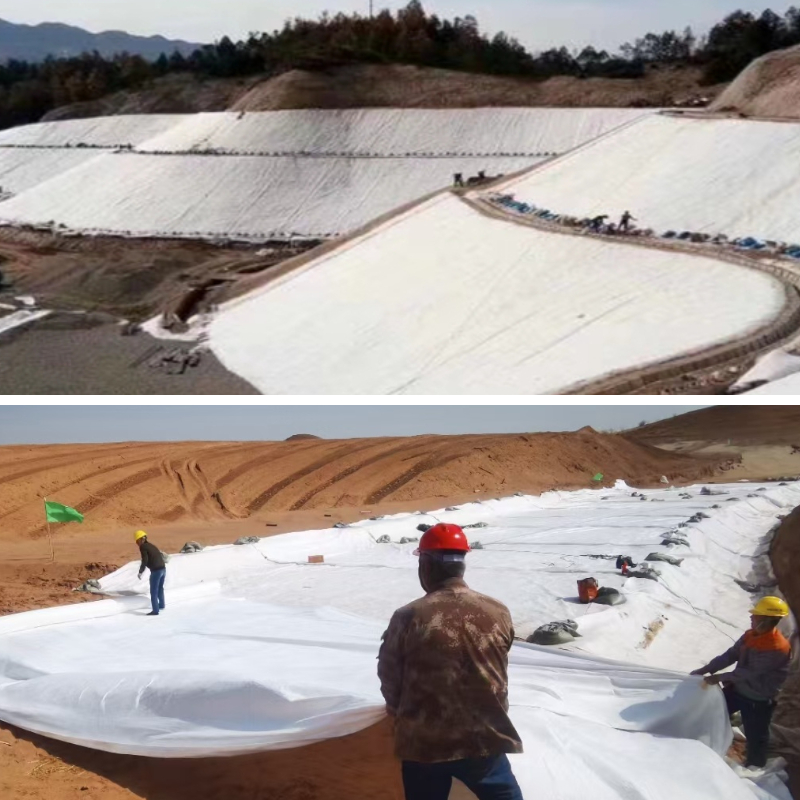Industrial Geotextile Fabric
1. Soil and Water Filtration & Erosion Prevention:It can filter water and soil, retain soil particles while allowing water penetration, and prevent soil erosion.
2. High-Efficiency Drainage & Environmental Adaptability:It has high drainage efficiency, can quickly drain stagnant water, and is also adaptable to complex environments such as low temperatures and high salinity.
3. Material Layer Isolation & Structural Stability:It can isolate different material layers, prevent mixing and damage, and ensure the stability of engineering structures.
4. High Tensile Strength & Service Life Extension:It has high tensile strength and aging resistance, which can enhance soil bearing capacity and prolong the service life of projects.
Product Introduction
I. Basic Properties
Industrial Geotextile Fabric are flexible sheet-like engineering materials mainly made from synthetic fibers such as polypropylene and polyester, manufactured through processes such as weaving, needle-punching, and thermal bonding. They have clear basic physical properties, with a certain thickness and porosity. Conventional products usually have a grammage range of 100-800g/㎡ and a tensile strength of 10-50kN/m. Additionally, they possess high chemical stability and are not prone to reacting with acids, alkalis, or salts, making them suitable for basic application scenarios in industrial infrastructure construction.
II. Core Functions
Filtration and Retention: Through its precise pore structure, it traps fine particles (such as clay and silt) in the soil while allowing normal penetration of water and air, preventing "clogging" issues in water conservancy projects and subgrade drainage systems;
Drainage and Diversion: Utilizing the flow-guiding property of the fiber layer, it quickly drains accumulated water inside the soil (e.g., pore water in slopes, seepage water in subgrades), reducing the internal water pressure of the structure and minimizing the risks of landslides and settlement;
Isolation and Separation: Acting as a "physical barrier" between different material layers, it separates the gravel layer from the soft soil layer in subgrades, and the anti-seepage membrane from the backfill soil in landfills, preventing the degradation of structural performance caused by material mixing;
Reinforcement and Strengthening: Relying on its high tensile strength, it bears stress in coordination with the soil, improving the bearing capacity of soft foundations (by 20%-50%) or enhancing the anti-sliding stability of slopes and embankments.
III. Main Characteristics
High Durability: It has excellent aging resistance (UV resistance, oxidation resistance) and corrosion resistance. Under normal circumstances, its service life can reach 30-50 years, meeting the "long-term service" requirements of industrial projects;
Wide Adaptability: It can work stably in complex environments such as low temperatures (-30℃ to -20℃), high salinity (coastal areas), and humidity. Moreover, it has good flexibility and can be laid to fit irregular terrain;
High Cost-Effectiveness: It features convenient construction (can be cut and spliced) without the need for complex equipment. Meanwhile, it can reduce the usage of traditional materials (such as sand and gravel), lowering the overall project cost;
Environmental Friendliness: Most products are recyclable and reusable, and no toxic or harmful substances are emitted during the production process, conforming to the development direction of "green infrastructure" in modern industry.
Product Parameters
project | metric | ||||||||||
Nominal strength/(kN/m) | |||||||||||
6 | 9 | 12 | 18 | 24 | 30 | 36 | 48 | 54 | |||
1 | Longitudinal and transverse tensile strength / (kN/m) ≥ | 6 | 9 | 12 | 18 | 24 | 30 | 36 | 48 | 54 | |
2 | Maximum elongation at maximum load in longitudinal and transverse directions/% | 30~80 | |||||||||
3 | CBR top penetration strength /kN ≥ | 0.9 | 1.6 | 1.9 | 2.9 | 3.9 | 5.3 | 6.4 | 7.9 | 8.5 | |
4 | Longitudinal and transverse tearing strength /kN | 0.15 | 0.22 | 0.29 | 0.43 | 0.57 | 0.71 | 0.83 | 1.1 | 1.25 | |
5 | Equivalent aperture O.90(O95)/mm | 0.05~0.30 | |||||||||
6 | Vertical permeability coefficient/(cm/s) | K× (10-¹~10-), where K=1.0~9.9 | |||||||||
7 | Width deviation rate /% ≥ | -0.5 | |||||||||
8 | Unit area mass deviation rate /% ≥ | -5 | |||||||||
9 | Thickness deviation rate /% ≥ | -10 | |||||||||
10 | Thickness coefficient of variation (CV)/% ≤ | 10 | |||||||||
11 | Dynamic perforation | Puncture hole diameter/mm ≤ | 37 | 33 | 27 | 20 | 17 | 14 | 11 | 9 | 7 |
12 | Longitudinal and transverse fracture strength (grab method)/kN ≥ | 0.3 | 0.5 | 0.7 | 1.1 | 1.4 | 1.9 | 2.4 | 3 | 3.5 | |
13 | Ultraviolet resistance (Xenon arc lamp method) | Longitudinal and transverse strength retention rate% ≥ | 70 | ||||||||
14 | Ultraviolet resistance (fluorescence UV lamp method) | Longitudinal and transverse strength retention rate% ≥ | 80 | ||||||||
Product Application
1.Transportation Engineering Field: Mainly used in the construction of highways, railways, and airport runways. Laid at the bottom of subgrades, between subgrade layers, or in track bases, it can isolate soft soil from gravel layers to prevent a decrease in bearing capacity, reinforce and enhance subgrade strength to reduce settlement (e.g., the settlement of soft soil subgrades can be reduced by 30%-50%). It can also divert seepage water and filter impurities to prevent road surface cracking, mud pumping, track deformation, and airport runway cracks, ensuring the stability and safety of transportation infrastructure.
2.Water Conservancy and Hydropower Engineering Field: Suitable for embankments, rivers, reservoirs, hydropower stations, and water conveyance channels. Used as a filter layer on the water-facing slope of embankments to intercept sediment and prevent soil erosion, while draining seepage water to reduce the water pressure of embankments and prevent piping. During river regulation, it is laid on the surface of riverbank slopes (can be combined with vegetation) to prevent soil erosion; when used with anti-seepage membranes at the river bottom, it protects the membrane from being punctured by sharp rocks. Laid around the slopes of water conveyance channels and pipelines of hydropower stations, it can isolate soil from anti-seepage membranes to prevent blockage, and reduce water scouring and pipeline corrosion.
3.Environmental Protection Engineering Field: Applied in landfills, sewage treatment plants, and soil remediation projects. In landfills, it is covered on top of anti-seepage membranes to prevent puncture by sharp objects and avoid leachate pollution to soil and water; it also filters leachate to prevent blockage of collection pipelines. In sewage treatment, it is used in sedimentation tanks to filter suspended particles, as a support layer for filter media in biological filters, or as filter cloth in sludge filter presses for sludge dewatering and volume reduction. During soil remediation, it is placed between contaminated and uncontaminated soil to form a barrier, blocking the spread of pollutants, and can also be used with remediation agents to filter leaching water.
4.Municipal Engineering Field: Serves underground utility tunnels, building foundations, sponge cities, and landscape greening. Wrapped around the outer walls of underground utility tunnels to isolate corrosive substances in underground soil and water, extending their service life; laid in the cushion layer at the bottom to divert seepage water and prevent settlement. Covered on the slopes of building foundations and the outer sides of diaphragm walls, it is used with anti-seepage membranes to prevent groundwater infiltration and ensure construction safety, while filtering soil particles to prevent blockage of wall joints. In sponge cities and landscape greening, it is laid under permeable pavements to form a drainage layer for flood prevention; when used with anti-seepage membranes at the bottom of artificial lakes, it isolates soil from water to prevent water pollution and protect the membrane.
5.Mining and Agricultural Fields: In mining, it is used in the filter layers and drainage layers of tailings dams to prevent the loss of tailings particles and avoid dam instability, and diverts seepage water to reduce the risk of dam failure. In agriculture, it can be used as a filter in water-saving irrigation systems to remove sediment and prevent blockage of drip irrigation tapes; it can also act as an isolation layer in saline-alkali soil improvement to block the upward seepage of underground saline-alkali and improve soil quality.
In summary, the application of industrial geotextiles covers the core links of engineering in various fields. Through the "functional combination of filtration, drainage, isolation, and reinforcement", it accurately addresses pain points such as settlement, scouring, pollution, and blockage in different scenarios. It not only improves the structural stability and service life of projects but also meets the requirements of modern infrastructure construction for efficiency, environmental protection, and economy, making it an indispensable key material in engineering construction across all fields.












